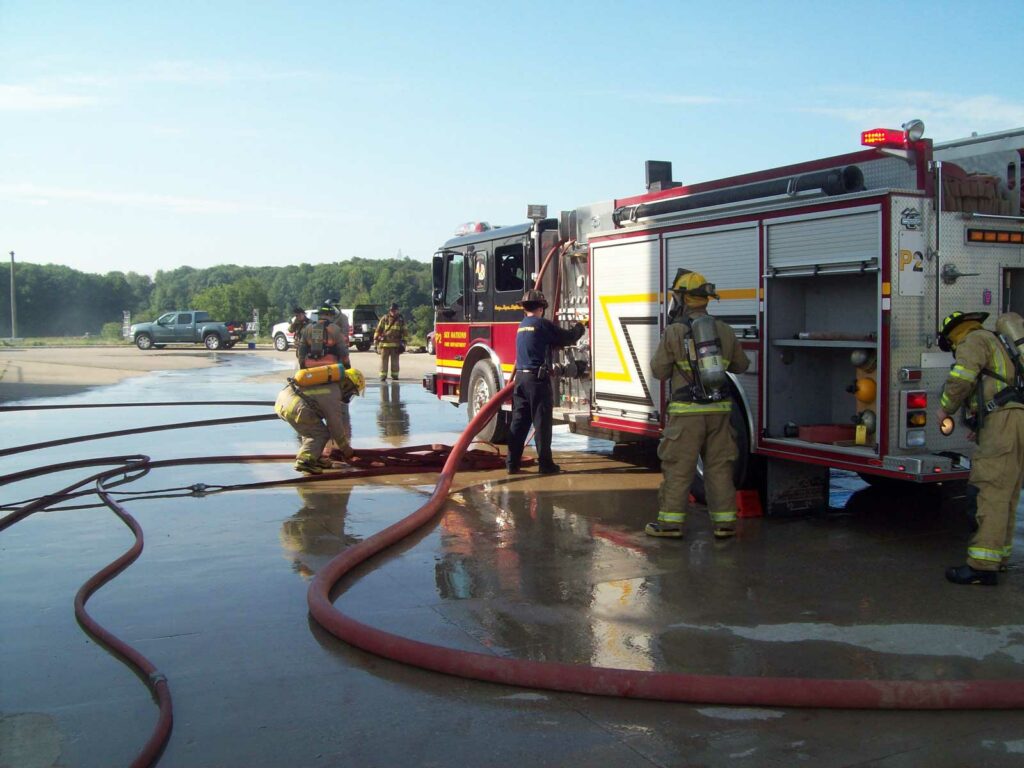We are continuing our look at engine company operations with getting water to and on the fire. In our last session we looked at the steps taken and needed for advancing the preconnect handline. As basic as this skill is, it is a vital skill to know and to be proficient with so that the interruption of suppression efforts is reduced. This month we are going to look at the third part of the process evaluation of our “roll in” drill for getting water to and on the fire: getting water from the truck to the nozzle.
In this section of our process evaluation, the two key people involved are going to the pump operator/driver and the nozzleman. Communication between these two people is paramount for this series of actions to play out right. Once the truck has come to a complete stop, the other steps described in our previous two articles come to life. The water supply is being secured while the preconnect handline is being pulled and advanced to the structure’s front door.
RELATED FIREFIGHTER TRAINING
Fireground Pump Operations: Mastering the Panel
Loss of Water: Every Engine Chauffeur’s Nightmare
Spurgeon: Friction Loss Rules of Thumb
Spurgeon: Every Pump Operator’s Basic Equation
At this point, the pump operator can easily send water from the on-board water tank to the nozzle. The goal here is to get water as quickly as possible to the nozzle so that a fast attack or an aggressive interior attack can be commenced; this can be accomplished with the onboard water supply. Every fire truck that is equipped with a pump and hose will have an onboard water supply–how much this supply is will depend upon departmental/apparatus specifications. Typically, the supply will be about 500 gallons, which is enough water for us to initiate an interior attack with a 1 ½- or 1 ¾-inch handline. Even a 2 ½-inch handline can be used using the onboard water supply – it just will not last as long as compared to a smaller handline.

The pump panel (photo 1) of a fire truck can be a confusing thing to look for those who are not familiar with it, but with lots of practice and hands-on training time, it becomes quite simple to operate. No matter what type of fire apparatus you are using, the principles of operating a pump are the same even though the layout may be different in terms of gauges, buttons, and levers. The pump operator (photo 2) is going to send water from the onboard water tank to the pump. This will be accomplished by opening the tank to pump valve on the panel. Once water has entered the pump, the corresponding valve for the handline can be opened when requested by the nozzleman.

The nozzleman must tell the pump operator when it is okay to send water to the nozzle. Once the hose has been flaked out and ready to be charged, the nozzleman can inform the pump operator either by radio transmission or by yelling/hand gestures to indicate “send the water.” The hand gesture commonly used is the one hand raised in the air with the index finger pointing up and the whole hand moving in a circular fashion. This will indicate to the pump operator to charge the line.
Once there is water sent into the handline, the pump operator needs to increase the pump pressure in the handline to be adequate for interior fire suppression activities. The pump pressure will be dictated by hydraulic calculations being done by the pump operator on the spot. These numbers are usually predetermined ahead of time based upon the preconnected hand lines.
Once there is water flowing with adequate pump pressure, the pump operator needs to set up their water supply so that continuation of water flow can occur when the water in the tank starts to run low. Depending on the type of water supply being used— hydrant or draft operation—the pump operator will either be able to accomplish this themselves on their own or will need the aid of another firefighter.
Using a hydrant supply will allow the pump operator to complete the water set up to the fire truck pump intake. This will be completed by grabbing the large-diameter hose from off the back of the truck and connecting it into the intake valve. If the hydrant was secured as mentioned in part 1 of our series, then this will be the only step the pump operator has to take to complete the water setup. Once connected to the pump intake, they can then signal to the hydrant firefighter to send water.
If using a portable water tank and rural water operations, the setup will require pulling off the water tank from off the truck (whether it is on the same truck or on a different truck) and opening it up beside the pump panel area. This will usually be a flat-level ground with a tarp underneath it. The hard suction hose will then be connected from the intake of the pump going into the water tank, having a suction device of some sort attached to the other end. This will usually be a flat pancake-style device for a water tank setup. A floating style can also be used for this type of setup. Once the water tank has been set up with the hard suction hose in place, water then can be dumped into it from the tenders on site.
At this point, the handlines have been charged and flowing water, the water supply has been established, and the pump operator can now keep their eye on the operation of the pump to make sure nothing goes awry.

Mark van der Feyst has been in the fire service since 1999 and is a full-time firefighter in Ontario, Canada. He is an international instructor teaching in Canada, the United States, and India, and at FDIC. Van der Feyst is a local level suppression instructor for the Pennsylvania State Fire Academy. He is also the lead author of Residential Fire Rescue (Fire Engineering Books & Video).
MORE MARK VAN DER FEYST
Firefighting Basics: Getting Water to and on the Fire, Part 1 | Part 2
Firefighter Basics: Calling the Mayday

